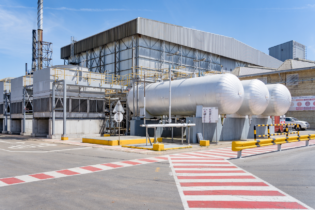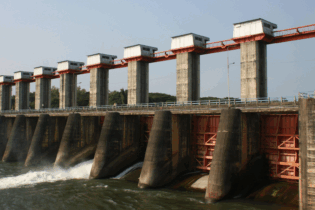The November 2013 United Nations climate change conference identified human actions as the dominant cause of global warming and highlighted anurgent need to reduce carbon emissions by at least 4% per annum in order to stay within the global carbon budget and prevent further harm to the environment. Alongside other major industrial sectors, the cement industry has a major obligation to contribute towards achieving this objective, particularly since the traditionally resource-intensive cement making process has resulted inthis industry being ranked among the world’s top contributors of carbon dioxide(CO2)emissions.
Traditional cement making consumes large quantities of materials such as limestone and other minerals. Although limestone is currently an abundant resource, it is non-renewable. At the same time, the energy required to power the kilns during clinker production is considerable releasing high volumes of environmental emissions into the atmosphere. Energy conservation has become a major focus area in the cement industry because, apart from ever-increasing energy costs, there are growing concerns over future energy availability. In South Africa, thethermal energy required to power the kilns is predominantly derived from coal (direct feed into the kiln) and electricity from the national grid. Every ton of clinkerproduced from this process burns about 200kg of coal. Burning coal and other fuelsproduces undesirable greenhouse gases. Both this process and the calcination of limestone and clay materials releases additional CO2 into the atmosphere. On average, the amount of CO2released is almost 900kg for every 1000kg of cement traditionally produced. Consequently, the cement industry worldwideis judged to be responsible for about 5% of the total carbonemissions into the atmosphere — among the highest industry in the world. A typical cement plant presents several additional environmental challenges that must be managed at each stage of production including dust emissions during blasting activities at quarries and at the cement factories and the noise associated with these activities. The drive to achieve economic growth is invariably associated with an increase in demand for cement and other building materials and this has prompted the industry to find new ways to overcome the associated environmental challenges and so embrace the challenge of making cement production a sustainable process. This robust commitment has already led to the introduction of several cutting-edge initiatives to mitigate environmental degradation, including technologies that make it possible to reduce energy and resource consumption at all levels of production. Green manufacturing calls for the preservation of natural resources and the reduction and, wherever possible, elimination of harmful pollutants released into the atmosphere especially CO2. There have been widespread calls for green cement with industry groups around the world adopting different sustainable cement initiatives. These approaches range from pushing for the reform of international building codes, to finding alternative solutions to traditional high energy intensive cements. AfriSam signalled theauthenticity of its environmental conscience more than 15 years ago with the introduction of an ahead-of-its-time environmental policy— long before “green”, “sustainability” and “environmentally friendly” became universal buzz-words. In fact, itwasthe first cement producer in the world to develop an environmental policy of this kind. AfriSam implementsthe drive towards “greening” its industry at several different levels simultaneously, definitively positioning it as a South African market leader. In 2000 the company implemented a fully-fledged CO2 reduction programme and set ambitious targets to reduce emissions associated with its products, then took its first major step towards CO2 reduction by launching Project Green Cement that same year.Between 1990 and 2012, AfriSam reduced its CO2 emissions per ton of cement by more than 30%. In 2009 the company introduced a world first CO2 rating system on all its cement bags, which means that the carbon footprint of each AfriSam product is printed on every bag.
Advanced fuel and energyefficient technologies play a major role in reducing emissions and AfriSam was the first South African company to install a much more energy-efficient vertical roller mill for grinding for cement. When AfriSam began Project Green Cement it installed state-of-the-art blenders that allowed the company to blend to cement with mineral components (Mic). These Micresult in a reduction in excess of 40% on electrical and thermal energy used in the cement production processThe company has also invested in major energy efficient upgrades of equipment at its production plants and employed a team of process engineers to extract maximum energy efficiency from each plant component. These measures, alongside behavioural, educational and staff advocacy initiatives, have yielded significant energy savings. Using 2000 as its base year, AfriSam has reduced its electrical energy consumption by 25% and its thermal energy consumption by 40%. Another industry focus area is to reduce the use of natural resources through the increased production of composite cements, sometimes called extended cements. This is evidence of industry’s growing willingness to make environmentally responsible decisions and the resulting technological advancements have afforded cement manufacturers the luxury of using alternative materials that possess cementious properties and have a low carbon footprint. By definition, composite cements are produced using a combination of clinker and an increased proportion of pozzolanic mineral components. Typically, these include by-products from other industries such as Ground Granulated Blast Furnace Slag (GGBFS) from the steel manufacturing industry, Pulverised Fly Ash (PFA) from coal-powered stations and silica fume, a by-product of silicon and ferrosilicon alloy production. For the past two decades, AfriSam has conducted extensive research and development into the production of these advanced cements replacing the environmentally unfriendly clinker and reducing itscarbon footprint dramatically. AfriSam has poured considerable capital investment into upgrading its production facilities to produce advanced composite cements, resulting in a reduction in the clinker factor from a world average of about 90% to an average of 60%, with reductions to as low as 35% for its particularly environmentally friendly Eco Building Cement. Years of research at its Centre for Product Excellence have led to the composite cement technology that is today applied to all AfriSam products, including its innovative new 42.5N All Purpose Cement, an advanced composite cement with active mineral components. This technology makes it possible to achieve greater concrete yield per bag of cement than before, without compromising performance. Interestingly, concrete made from the company’s 42.5N cement continues to gain strength past the traditional 28-day cut-off, actually improving with time to achieve stronger structures.







